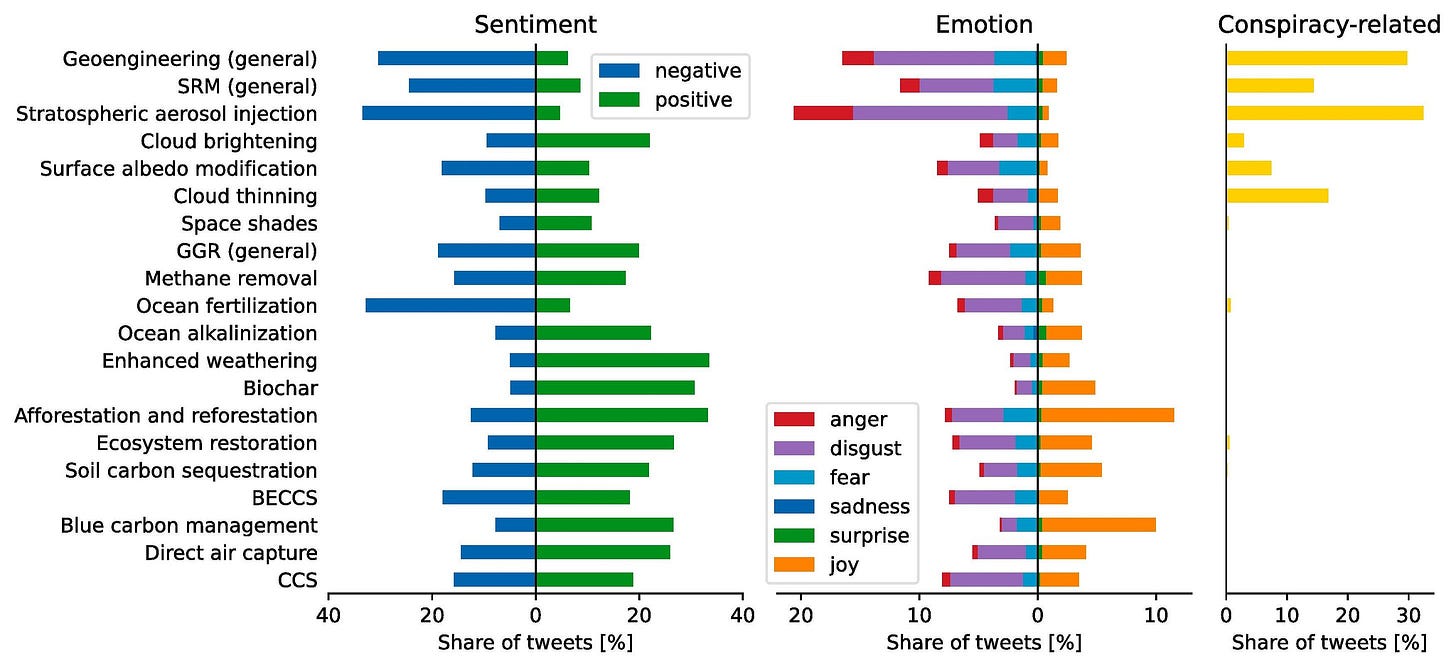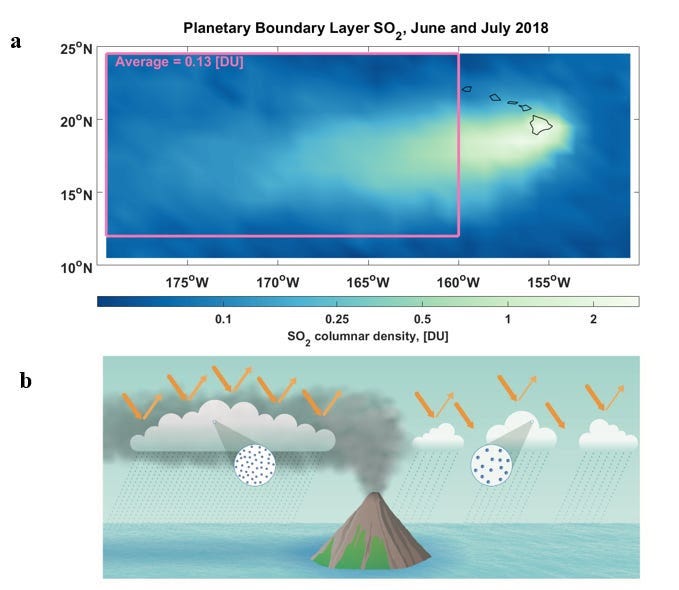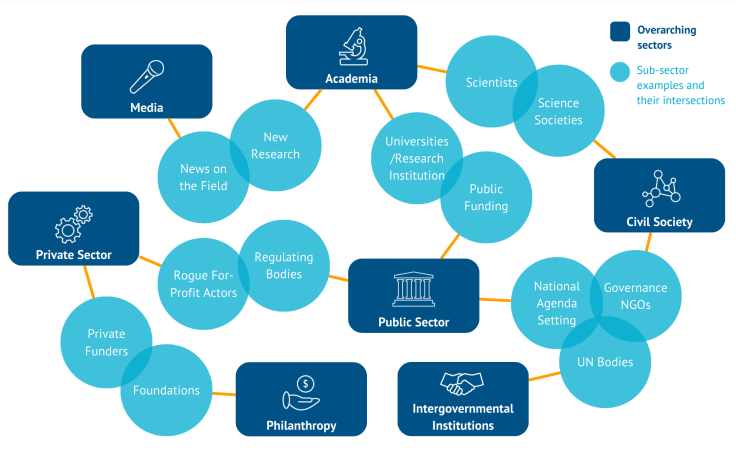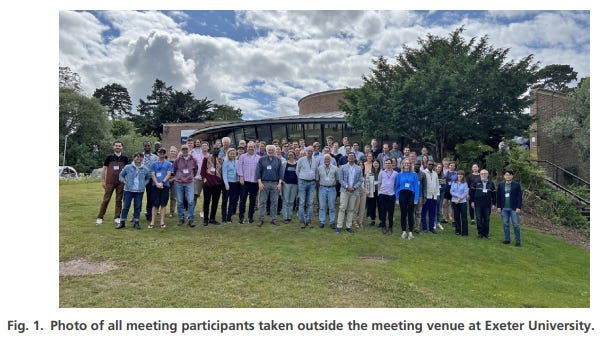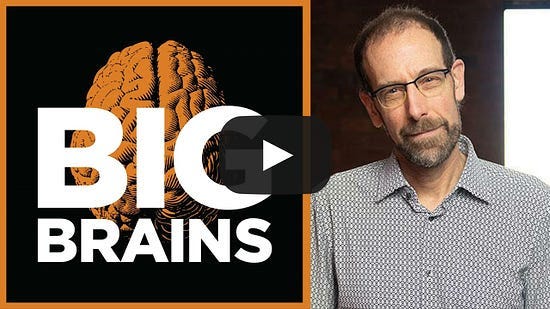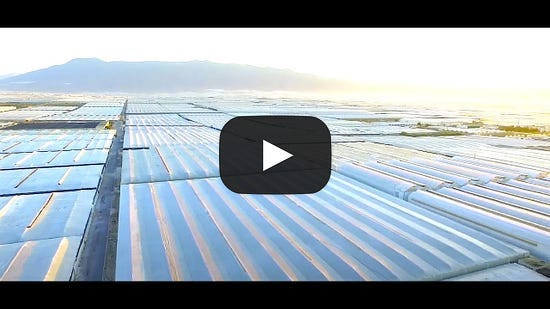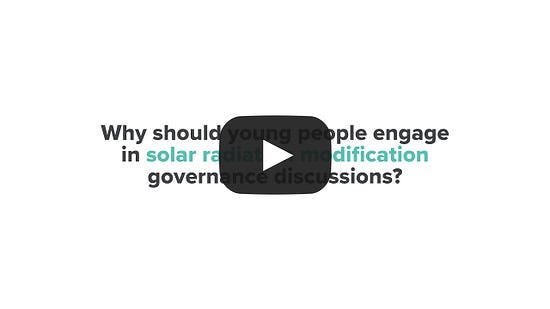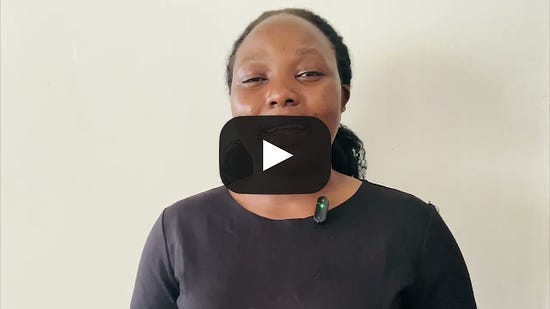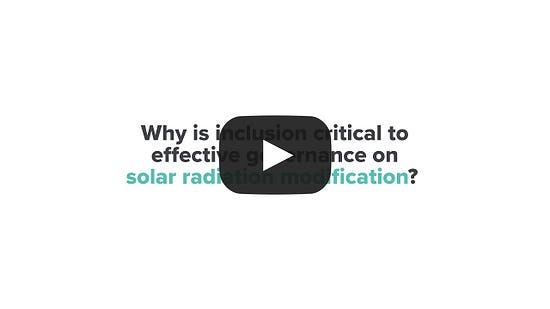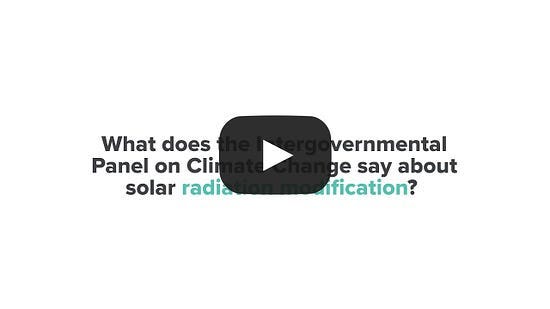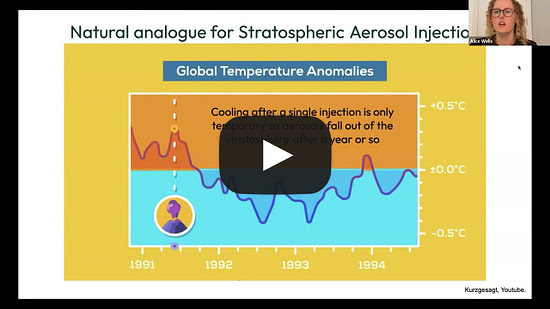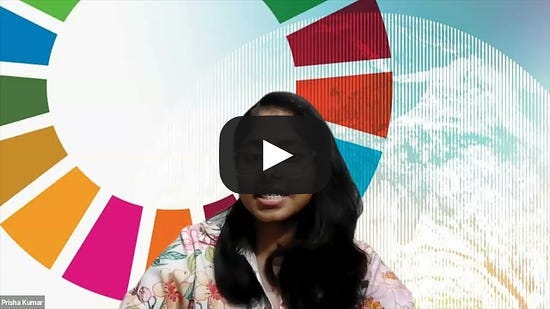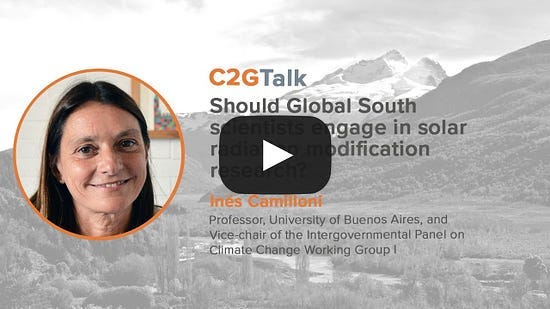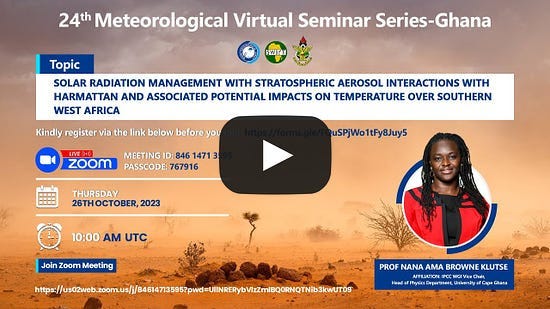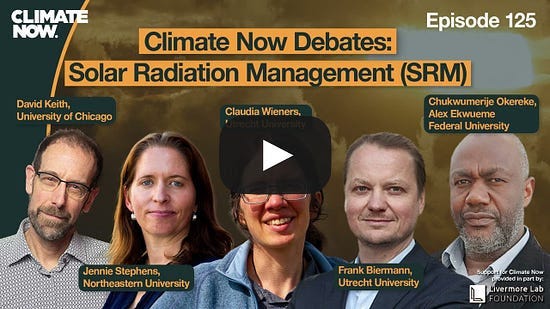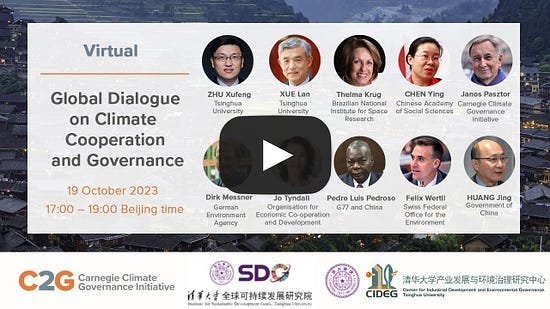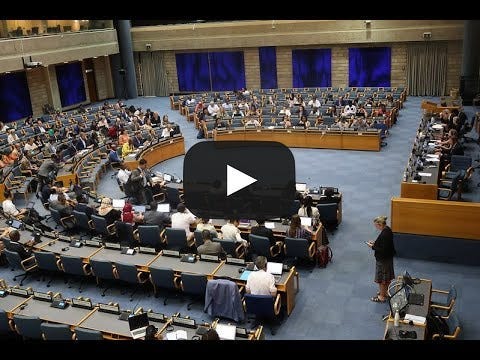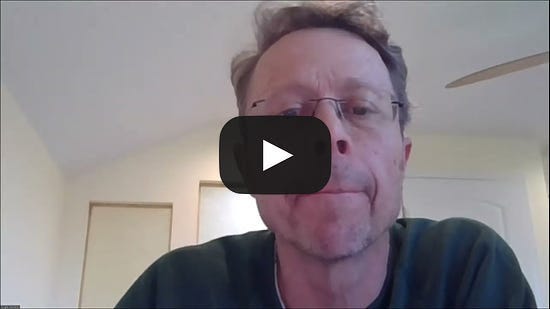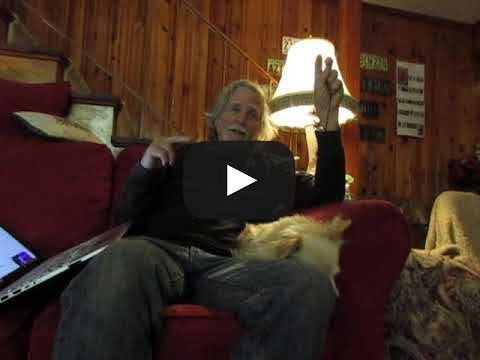Chen, Y., Haywood, J., Wang, Y., Malavelle, F., Jordan, G., Peace, A., ... & Lohmann, U. (2023). Evidence that deliberate marine cloud brightening can be more effective than previously thought. UMBC Faculty Collection.
Wang, J., Zhang, Z., Crabbe, M. J. C., & Das, L. C. (2023). Responses of Extreme Climates in South Asia under a G6sulfur Scenario of Climate Engineering. Atmosphere, 14(10), 1490.
Bonou, F., Da‐Allada, C. Y., Baloitcha, E., Alamou, E., Biao, E. I., Zandagba, J., ... & Tilmes, S. (2023). Stratospheric sulfate aerosols impacts on West African monsoon precipitation using GeoMIP models. Earth's Future, 11(11), e2023EF003779.
Ricke, K., & Harding, A. (2023). How may solar geoengineering impact global prospects for climate change mitigation?. Oxford Review of Economic Policy, 39(4), 828-841.
Moore, J. C., Greve, R., Yue, C., Zwinger, T., Gillet‐Chaulet, F., & Zhao, L. (2023). Reduced ice loss from Greenland under stratospheric aerosol injection. Journal of Geophysical Research: Earth Surface, 128(11), e2023JF007112.
Dagan, G., Yeheskel, N., & Williams, A. I. (2023). Radiative forcing from aerosol–cloud interactions enhanced by large-scale circulation adjustments. Nature Geoscience, 1-7.
Wheeler, L. Zeitler, T. Brunell S., et al. (2023). Performance Assessment for Climate Intervention (PACI): Preliminary Application to a Stratospheric Aerosol Injection Scenario. Front. Environ. Sci. Volume 11.
Usman, H., Qamar, N. S., & Subhani, M. U. Regulating Geoengineering Technologies to Address Climate Change: An International Law Perspective.
Chuffart, R., Cooper, A. M., Wood-Donnelly, C., & Seddon, L. (2023). Old Sea, New Ice: sea ice geoengineering and indigenous rights in Arctic Ocean governance. The Polar Journal, 1-21.
Yuan, T., Song, H., Wood, R., Oreopoulos, L., Platnick, S., Wang, C., ... & Wilcox, E. (2023). Observational evidence of strong forcing from aerosol effect on low cloud coverage. Science Advances, 9(45), eadh7716.
Laakso, A., Visioni, D., Niemeier, U., Tilmes, S., & Kokkola, H. (2023). Dependency of the impacts of geoengineering on the stratospheric sulfur injection strategy part 2: How changes in the hydrological cycle depend on injection rates and model?. EGUsphere, 2023, 1-29.
Taylor, G. M., Wadhams, P., Visioni, D., Goreau, T., Field, L., & Kuswanto, H. (2023). Bad science and good intentions prevent effective climate action.
Hueholt, D., Barnes, E., Hurrell, J., & Morrison, A. (2023). Climate speeds help frame relative ecological risk in future climate change and stratospheric aerosol injection scenarios.
Goddard, P. B., Kravitz, B., MacMartin, D. G., Visioni, D., Bednarz, E. M., & Lee, W. R. (2023). Stratospheric aerosol injection can reduce risks to Antarctic ice loss depending on injection location and amount. Journal of Geophysical Research: Atmospheres, 128(22), e2023JD039434.
Rosenthal, S., Irvine, P. J., Cummings, C. L., & Ho, S. S. (2023). Exposure to climate change information predicts public support for solar geoengineering in Singapore and the United States. Scientific Reports, 13(1), 19874.
Virgin, J. G., & Fletcher, C. G. (2023). Declining Geoengineering Efficacy Caused by Cloud Feedbacks in Transient Solar Dimming Experiments. Journal of Climate.
Baur, S., Terray, L., Séférian, R., & Sanderson, B. M. (2023). Change in wind energy potential under Solar Radiation Modification. In XXVIII General Assembly of the International Union of Geodesy and Geophysics (IUGG). GFZ German Research Centre for Geosciences.
Yuan, T., Song, H., Oreopoulos, L., Wood, R., Bian, H., Breen, K., ... & Platnick, S. (2023). Substantial Radiative Warming by an Inadvertent Geoengineering Experiment from 2020 Fuel Regulations.
Burke, A., Innes, H. M., Crick, L., Anchukaitis, K. J., Byrne, M. P., Hutchison, W., ... & Wilson, R. (2023). High sensitivity of summer temperatures to stratospheric sulfur loading from volcanoes in the Northern Hemisphere. Proceedings of the National Academy of Sciences, 120(47), e2221810120.
Bossy, T., Gasser, T., Ciais, P., Tanaka, K., Lecocq, F., & Bousquet, P. (2023). Spaces of anthropogenic CO2 emissions compatible with planetary boundaries.
Christensen, M. W., Wu, P., Varble, A. C., Xiao, H., & Fast, J. D. (2023). Aerosol-Induced Closure of Marine Cloud Cells: Enhanced Effects in the Presence of Precipitation. EGUsphere, 2023, 1-35.
Bednarz, E. M., Butler, A. H., Visioni, D., Zhang, Y., Kravitz, B., & MacMartin, D. G. (2023). Injection strategy–a driver of atmospheric circulation and ozone response to stratospheric aerosol geoengineering. Atmospheric Chemistry and Physics, 23(21), 13665-13684.
Peccia, A., Moussallam, Y., Plank, T., DallaSanta, K., Polvani, L., Burgisser, A., ... & Schaefer, J. (2023). A New Multi‐Method Assessment of Stratospheric Sulfur Load From the Okmok II Caldera‐Forming Eruption of 43 BCE. Geophysical Research Letters, 50(21), e2023GL103334.
Dumelié, N., Vernier, J. P., Berthet, G., Vernier, H., Renard, J. B., Rastogi, N., ... & Joly, L. (2023). Toward Rapid balloon Experiments for sudden Aerosol injection in the Stratosphere (REAS) by volcanic eruptions and wildfires. Bulletin of the American Meteorological Society.
Fan, Y. (2023). Unequal effects of climate intervention on agriculture. Nature Food, 1-2.
James E Hansen, Makiko Sato, Leon Simons, Larissa S Nazarenko, Isabelle Sangha, Pushker Kharecha, James C Zachos, Karina von Schuckmann, Norman G Loeb, Matthew B Osman, Qinjian Jin, George Tselioudis, Eunbi Jeong, Andrew Lacis, Reto Ruedy, Gary Russell, Junji Cao, Jing Li. (2023). Oxford Open Climate Change, Volume 3, Issue 1, 2023, kgad008.
Senel, C. B., Kaskes, P., Temel, O., Vellekoop, J., Goderis, S., DePalma, R., ... & Karatekin, Ö. (2023). Chicxulub impact winter sustained by fine silicate dust. Nature Geoscience, 1-8.
Müller-Hansen, F., Repke, T., Baum, C. M., Brutschin, E., Callaghan, M. W., Debnath, R., ... & Minx, J. C. (2023). Attention, sentiments and emotions towards emerging climate technologies on Twitter. Global Environmental Change, 83, 102765.
Share Solar Geoengineering Updates
Abstract
Methods of geoengineering are provided to create shade by reflecting solar radiation into space to mitigate global warming, as well as reduce storm severity, and other applications. These methods rely on dispersing hollow silicate microspheres into the atmosphere, or into orbit, by aircraft or rocket, where the silicate microspheres can optionally comprise additions of one of boron or sodium, or both. Silicate microspheres manufactured on the Moon can be delivered to Earth or L1 orbit as an alternative to lofting from Earth’s surface. Hollow silicate microspheres are more than 6 times the size of comparable solid SRM particles. This method substantially improves reflectivity, solar-powered lofting, and, in the presence of liquid water aerosols, the greater surface area enables improved carbon dioxide capture.
“Solar geoengineering technology holds possibilities and pitfalls, renowned scientist argues.
Climate change can feel like an impossible crisis these days. Every week there is some new report about the irreversible damage we’re doing to our planet and the havoc it will bring to people’s lives. We all know cutting emissions is the solution, yet governments and companies seem no closer to meeting the goals that scientists say we must hit. It can feel hopeless.
There is one possible controversial solution to climate change many in the mainstream haven’t discussed. It’s so controversial, in fact, that some experts say we shouldn’t even be discussing it. But University of Chicago Professor David Keith says we need to talk about it. It’s called solar geoengineering—the process in which you reflect a small fraction of sunlight back into space using aerosols. As the founding director of the Climate Systems Engineering Initiative at UChicago, Keith is leading a team that will research solar geoengineering and other novel solutions to climate change.”
“Good afternoon, Reviewer 2 listeners. Some of us at the Healthy Planet Action Coalition (www.healthyplanetaction.org) have noticed that a few months ago Reviewer 2 experienced a security breach orchestrated by archrival Challenging Climate. Now normally we would refrain from taking advantage of poor Reviewer 2, but we sensed an opportunity that we couldn’t resist and decided to jump into the breach with this discussion about the recent report of the Climate Overshoot Commission (COC) between Chris Field, Stanford Professor and advisor to the COC, and Mike MacCracken, HPAC Steering Circle member and former Executive Director of the Office of the US Global Change Research Program.
The Climate Overshoot Commission report "Reducing the Risks of Climate Overshoot" was released on September 14: https://www.overshootcommission.org/_files/ugd/0c3b70_bab3b3c1cd394745b387a594c9a68e2b.pdf. While the COC did not solicit public input, it did hold a series of meetings to learn and discuss the full range of questions facing the international community in dealing with the risk of climate overshoot. Their 4-part high-level recommendations were summarized in the acronym CARE, for Cut (emissions), Adapt, Remove (CO2), and Explore (SRM). Specifically, its recommendation on climate intervention advocated expanding research while placing "a moratorium on the deployment of solar radiation modification and large-scale outdoor experiments that would carry risk of significant trans-boundary harm.”
“It is important for scientists from the Global South to be engaged in research and discussions around solar radiation modification (SRM) because its potential impacts would affect everyone, says Inés Camilloni from the University of Buenos Aires. Researchers need to consider the risks of SRM against the risks of a dangerously warming planet. More research is needed, because the world currently does not know enough to make informed decisions.
Dr. Camilloni is currently associate professor at the Department of Atmospheric and Oceanic Sciences of the University of Buenos Aires, senior researcher of the National Scientific and Technical Research Council at the Center for Atmosphere and Ocean Research (CIMA) in Argentina, and vice-chair of the Intergovernmental Panel on Climate Change Working Group 1.”
“Geoengineering refers to the intentional intervention in Earth processes for the purpose of mitigating climate change. A controversial topic, geoengineering is typically divided into two categories: carbon dioxide removal and solar radiation management. This second category, also known as SRM, made headlines this summer when the White House released a report that “opened the door” to future research on the topic.
In principle, SRM includes any technology that could be used to reflect some of the sun’s energy from the Earth in order to decrease the amount of associated heating, effectively cooling the planet. And while the study of SRM has mostly been limited to the lab and to date no large-scale experiments have been conducted, more people are calling for the idea to be explored further as global warming increases. At the same time, others are saying the door needs to remain shut, as the potential for unintended political, societal and ecological side effects are just too great.
To help us understand why - why is SRM being considered, and why are people concerned that it is being considered, Climate Now brought together five experts – Professors Frank Biermann (Utrecht Univ.), David Keith (Univ. Chicago), Chukwumerije Okereke (Alex Ekwueme Federal Univ. Ndufu-Alike, Nigeria), Jennie Stephens (Northeastern Univ.), and Claudia Wieners (Utrecht Univ.) – to debate the merits and risks of examining SRM as a possible climate solution.”
"Engagement in SRM goverance discussions does not mean support of SRM"
“What are some of the most pressing ethical issues related to climate engineering? What are some key regulatory challenges related to climate engineering technologies, such as carbon removal? What role should climate engineering play in meeting the EU’s target of net zero by 2050? Bennet Francis, Dominic Lenzi, and Michel Bourban (UT) share their thoughts on climate engineering.”
“Solar geoengineering technology holds possibilities and pitfalls, renowned scientist argues Climate change can feel like an impossible crisis these days. Every week there is some new report about the irreversible damage we’re doing to our planet and the havoc it will bring to people’s lives. We all know cutting emissions is the solution, yet governments and companies seem no closer to meeting the goals that scientists say we must hit. It can feel hopeless. There is one possible controversial solution to climate change many in the mainstream haven’t discussed. It’s so controversial, in fact, that some experts say we shouldn’t even be discussing it. But University of Chicago Professor David Keith says we need to talk about it. It’s called solar geoengineering—the process in which you reflect a small fraction of sunlight back into space using aerosols. As the founding director of the Climate Systems Engineering Initiative at UChicago, Keith is leading a team that will research solar geoengineering and other novel solutions to climate change.”
“A crucial paper preprint was just released by Peter Wadham’s and his colleagues making a very strong case for the vital, absolute necessity of studying, scaling, and deployment of Solar Radiation Management (SRM).”
“We're going to be the ones long term dealing with the consequences and the possibilities and challenges created by this type of technologies and the lack of governance or the governance of it. Stephany Ferreira shares insights on why young people should be involved in Solar Radiation Modification (SRM) governance discussions.”
“Sarah Kwerit participated in C2G's Youth Voices for Emerging Climate Governance project; she shared her thoughts on the experience in this final learning diary.”
“Youth voices are becoming increasingly strong and needed as the youth generation today maybe the most affected by how this generation responds to the threat of Climate Change. Thelma Krug, the former Vice Chair of the IPCC, shares insights at SRM Youth Watch Launch event during New York Climate Week.”
“Joshua Amponsem is a Ghanaian climate activist and Co-Director of the new Youth Climate Justice Fund initiative. He is the former Climate Lead at the Office of the UN Secretary General’s Envoy on Youth. He has over 8 years of experience working with young people on Climate Action, Disaster Risk, and Resilience Building. He founded Green Africa Youth Organization (GAYO), served as a member of the IRENA Global Council on Enabling Youth Action for SDG 7, and has been an Adaptation Fellow at the Global Center on Adaptation(GCA).”
“Solar Climate Intervention Virtual Symposium 7
Chen Xing (University of California Santa Barbara): "Why does Marine Cloud Brightening dampen El Niño–Southern Oscillation?"
Dr. David Mitchell (Desert Research Institute, USA) : "Clearing Logjams in CCT Research"”
“Loann Marquant shares insights on the governance of Solar Radiation Modification during the launch event of SRM Youth Watch at New York Climate Week.”
“Alice Wells explains how stratospheric aerosol injection can cool the planet at the launch event of Solar Radiation Modification Youth Watch during New York Climate Week.”
“This video is an excerpt from the Solar Radiation Modification Youth Watch launch event, which took place during New York Climate Week. Prisha Kumar, a co-founder of the Institute for Climate Policy Solutions, was one of the panelists and shared her insights on how power dynamics could potentially jeopardize discussions on Solar Radiation Modification governance.”
“Thelma Krug, the former Vice Chair of the IPCC, shares insights at SRM Youth Watch Launch event during New York Climate Week.”
“It is important for scientists from the Global South to be engaged in research and discussions around SRM, because its potential impacts would affect everyone, says Inés Camilloni from the University of Buenos Aires. Researchers need to consider the risks of SRM against the risks of a dangerously warming planet. More research is needed, because the world currently does not know enough to make informed decisions.”
“Solar geoengineering is often discussed as a means to mitigate the impacts and injustice of climate change by reducing its magnitude. However, climate response to Solar Radiation Management simulation at a regional scale remains uncertain. In addition, the potential effects of geoengineering on temperature levels during the harmattan season in West Africa are not well understood. This study aims to project how geoengineering could impact harmattan temperatures by comparing current temperature trends under moderate and high greenhouse gas emissions scenarios (Representative Concentration Pathways 4.5 and 8.5) with and without geoengineering. The findings suggest that if geoengineering deployment cools the tropics during the harmattan season, it could potentially increase the discomfort caused by the cold and dry conditions that persist during the harmattan season, especially for those who are not accustomed to the cold. Additionally, the study indicates that geoengineering could offset the projected harmattan temperature reduction that may occur by 2070 without intervention. These results highlight the importance of considering the potential regional trade-offs that could arise from implementing geoengineering strategies to offset warming during the harmattan season in West Africa.”
“Geoengineering refers to the intentional intervention in Earth processes for the purpose of mitigating climate change. A controversial topic, geoengineering is typically divided into two categories: carbon dioxide removal and solar radiation management. This second category, also known as SRM, made headlines this summer when the White House released a report that “opened the door” to future research on the topic.”
“The Solar Radiation Modification Youth Watch (SRM YW) launch event aims to bring together young people to discuss the need for strengthening governance around solar radiation modification (SRM) whilst introducing and launching the SRM YW platform.”
“A virtual event between the Institute for Sustainable Development Goals, Tsinghua University (TUSDG), Center for Industrial Development and Environmental Governance, Tsinghua University (CIDEG), and Carnegie Climate Governance Initiative (C2G).”
“This episode of Weathered explores the controversial world of solar geoengineering by injecting sulfate aerosols into the stratosphere, looking at both the controversial promises and profound risks associated with manipulating the Earth's climate. Luke Iseman, the founder of Make Sunsets, tells us about his start up that is already releasing small amounts of sulfur dioxide into our skies. And then we speak with leading scientists from the non-use initiative against solar geoengineering or solar radiation management who warn against the potential dangers of this untested technology. Then we discuss the tragic drought and famine of the 1980s in the Sahel region of Africa and and its likely link to air pollution from the US and Europe. This episode sheds light on the intricate balance of our planet's weather and climate, and the human interventions that could change it forever.”
“On behalf of renowned climate scientist, Dr. James Hansen, we are pleased to share this virtual event entitled “An Intimate Conversation with Leading Climate Scientists To Discuss Ground-breaking New Research on Global Warming”.
Ahead of the upcoming COP28, renowned climate scientist, Dr. James Hansen, and his co-authors present the novel findings of his new paper Global Warming in the Pipeline.”
“Ms. Inger Andersen, Executive Director of the United Nations Environment Programme (UNEP), will hold a briefing for member states on her report to the sixth session of the United Nations Environment Assembly (UNEA-6).”
“This video is an excerpt from the Solar Radiation Modification Youth Watch launch event, which took place during New York Climate Week. Prisha Kumar, a co-founder of the Institute for Climate Policy Solutions, was one of the panelists and shared her insights on how power dynamics could potentially jeopardize discussions on Solar Radiation Modification governance.”
“Title: Model Simulations of Climate Interventions Aiming to Offset Future Warming: Insights and Uncertainties
Speaker: Associate Professor Douglas MacMartin, Cornell University
Talk Overview:
Decadal-average global warming is approaching 1.2 C and it is likely that the 1.5 C goal from the Paris Agreement will be passed in the next decade or so. Global warming is now being experienced through the increasing likelihood of severe weather, more intense storms, destabilization of major glacial streams, increasing rate of rise of sea level, and more, all driven by the ongoing emissions of greenhouse gas emissions.
With the present and projected pace of emissions mitigation, global warming is projected to at least double before net-zero emissions are reached up to a few decades after mid-century, with corresponding increased impacts and risks.
With all nations committed to the goal of keeping global warming to no more than 1.5 C and climate intervention becoming the only option for preventing further warming, modeling studies have started looking at climate intervention scenarios that would offset further warming, stabilizing the climate at 1.5C, or restoring back to 1.0C or lower.
Professor MacMartin reports on the status of climate stabilization studies using stratospheric aerosol injection (SAI), providing an overview of what would be involved, including options such as more polar-focused deployments, what the resulting stabilized climate would be like and how long it might take to reach a desired cooling, what the key uncertainties are and how they might compare to the types of consequences that might trigger calls for intervention, and what research is needed to provide the firmer information needed for early rather than late-stage emergency intervention to be considered as a potential policy scenario.
The recording includes a powerpoint presentation followed by question and answer with the audience.”
“In today's Chronicle of the Collapse, I wonder which Doomer team to join as James Hansen and Michael Mann cannot agree on the problem, much less the "solution" to it. Here is a link to an article in the Guardian titled, "Global heating is accelerating, warns scientist who sounded climate alarm in the 80s":https://news.yahoo.com/global-heating-accelerating-warns-scientist-040128187.html
Share Solar Geoengineering Updates
Leave a comment






